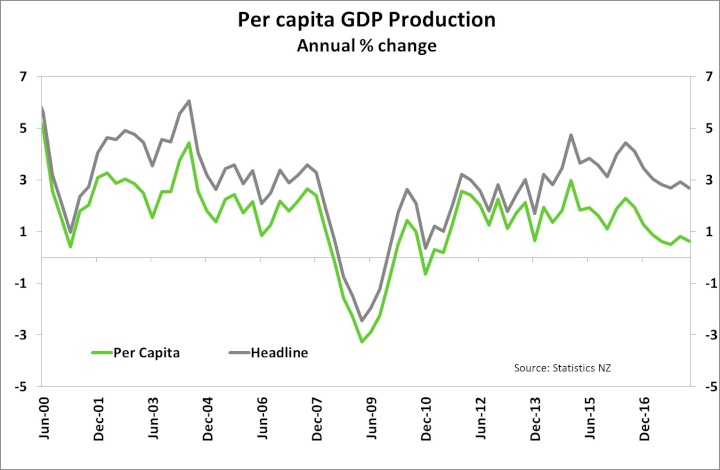It’s all about keeping it simple
It’s all about keeping it
simple
• The RBNZ is set to deliver another
simple and consistent message at Thursday’s OCR Review.
That is, until inflation is well on its way to the 2% target
midpoint the OCR is going nowhere.
• US President Trump
was at it again last week, taking aim at the Eurozone and
threatening import tariffs on European cars. Markets are
likely to remain on edge for more.
• Back home, ANZ’s
Business Outlook survey for June is out Wednesday.
General pessimism seems to pervade firms at present. Our
focus is on the outlook for firms own activity.
View PDF
Here’s our take on current events
The focus this week is on the RBNZ’s OCR review on Thursday. The RBNZ is expected to deliver another simple message. Until inflation is on a sustainable path back to the 2% target midpoint “The official cash rate (OCR) will remain at 1.75 percent for some time to come”.
Developments since the RBNZ’s May Monetary Policy Statement (MPS) have slightly increased the downside risks to the RBNZ’s outlook, but only slightly. For instance, March quarter GDP released last week was lower than the RBNZ’s forecast, but didn’t set off the alarm bells on the Terrace. The economy expanded 0.5% qoq in the March 2018 quarter, in line with our quarterly pick but weaker than the RBNZ’s 0.7% qoq pick. There were few surprises. The figures show an economy growing around trend, 2.7% yoy. It is important to put these figures in context. They’re old. We’re already finishing up the second quarter and talking about the first quarter. But the numbers give us a base to work off. The size of our economy is bang in line with economist expectations for the quarter, but much larger than economist expectations 6 months ago. All told, the economy is growing around trend and is still expected to perk-up and eventually require the OCR to be lifted – our current view is August next year.
The Organisation of the Petroleum Exporting Countries (OPEC) hit the headlines over the weekend, agreeing to lift production. The cartel signalled that it would lift production by a tiny 1mn barrels per day. Supply concerns among some members such as Venezuela and Iran have seen oil prices over recent months hit the highest mark since 2014. Oil prices lifted on the news, with some market participants expecting a larger increase. Brent crude oil finished the week up around 3% at US$75.5/barrel.
Also hitting the headlines at the end of the week was yet another tweet from US President Donald Trump on tariffs. This time the tweet was aimed at the Eurozone, with Trump threatening a 20% tariff on European cars imported into the States. Trump’s shot across the bow of the Eurozone adds to a worrying ratcheting up of trade tensions between the US and major trading partners. In addition, the tweet took the gloss of some decent data coming out of the Eurozone on Friday. The June services PMI rebounded to a reading of 55, in contrast to market expectations for no changed at 53.8.
Last week it was the Bank of England’s (BoE) turn to deliver its latest policy decision. As expected the Bank kept its policy interest rate unchanged at 0.5%. However, the news that BoE Chief Economist Andy Haldane switched his vote to a hike saw market pricing for an August hike lift to around 70%.
Our chart of the week shows a decline in EM
A feature of last week’s GDP release was another weak print of per capita GDP growth. GDP per capita flat lined over the quarter as StatsNZ recorded a lift in the population of 27,000 people. Per capita growth tends to fall short of headline growth figures, because not everyone can contribute to output. However, the gap between headline and per capita growth has widened over the last five years. At the same time NZ has experienced the strongest population growth since the since the 1970s – largely migration driven. The migrant boom has fuelled much of our growth. .
Easing net migration is likely to see the divergence between headline and per capita growth shrink in coming quarters. Last week annual net migration over May fell to 66,000, the lowest since early 2016. However, what is really needed is a meaningful lift on productivity growth . Another feature of March quarter GDP growth was a strong jump in investment by firms of plant, machinery and equipment. Increased spending on physical capital can help to lift productivity. But it’s clearly more complicated than simply a lack of machinery.



 RNZ: Parts Of Power System Could Be Out For 36 Hours In Event Of Extreme Solar Storm
RNZ: Parts Of Power System Could Be Out For 36 Hours In Event Of Extreme Solar Storm NZAS: New Zealand Association Of Scientists Awards Celebrate The Achievements Of Scientists And Our Science System
NZAS: New Zealand Association Of Scientists Awards Celebrate The Achievements Of Scientists And Our Science System Stats NZ: Retail Spending Flat In The September 2024 Quarter
Stats NZ: Retail Spending Flat In The September 2024 Quarter Antarctica New Zealand: International Team Launch Second Attempt To Drill Deep For Antarctic Climate Clues
Antarctica New Zealand: International Team Launch Second Attempt To Drill Deep For Antarctic Climate Clues Vegetables New Zealand: Asparagus Season In Full Flight: Get It While You Still Can
Vegetables New Zealand: Asparagus Season In Full Flight: Get It While You Still Can  Bill Bennett: Download Weekly - How would NZ telecoms cope with another cyclone
Bill Bennett: Download Weekly - How would NZ telecoms cope with another cyclone



